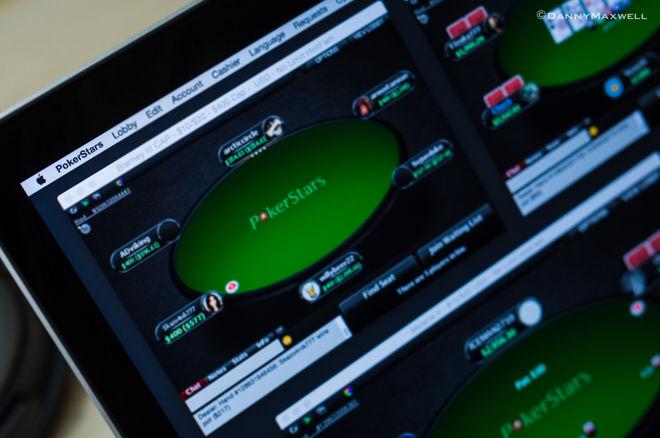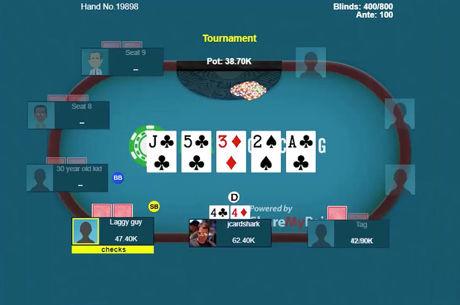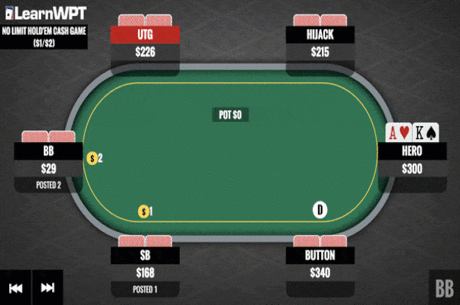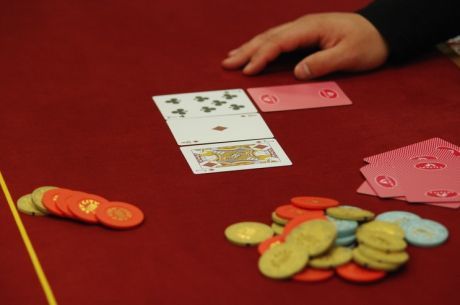Hand Analysis: A Negative Freeroll in a Multi-Way Pot

Multi-way pots expand rapidly, sometimes even when caution prevails. That's the nature of these multi-headed beasts — they cannot easily be tamed.
But as the following hand illustrates all too well, you don't have to run headlong into the jaws when multiple players are vying for a pot postflop.
Preflop Mania, and Probabilities
The game was $0.50/$1 no-limit hold'em (100NL), played online, and the hand began with the under-the-gun player opening to 2.2 big blinds. The cutoff three-bet to $3.50, the button cold-called the reraise, and both blinds and the original raiser called as well. Five-way to the flop!
That flop came A♣9♣10♠.
When there is a flopped flush draw multi-way and multiple players seem to want to continue, it is not unreasonable to put someone on a flush draw.
Try thinking about it like this. If you don't have a blocker, there are 11 unseen cards of the suit, two of which might well be in someone's hand. When two players show interest in such a flop, both could have a made hand, one or the other could be drawing, or both could be drawing. Moreover, when multiple players are wanting to continue, marginal made hands usually fall by the wayside, while a draw to something stronger than the best made hand can continue.
In this particular hand, four of the five players would put money into the pot on that A♣9♣10♠ flop. The big blind led out for $8, was called twice, and then raised by the button to $32.
We don't know for sure that one of these four players has a flush draw, but what we are figuring instead is the chance for all of them not to have one.
Then There Were Two
The big blind called the button's raise and the two players who had gotten everything started, the initial raiser and the three-bettor in the cutoff, got out of the way. Heads up to a Q♠ turn.
The big blind decided to lead out $47.50 into a pot that was $95, with $250 effective behind. This seems like a mistake with just about any hand.
First and foremost, the big blind's bet opens the action for a shove, so if the button raised the flop with a big made hand like 9x9x or 10x10x, he has the chance now to shut out any draws.
But consider if the button has a draw himself — he can just call now, for a great price, with deep stacks in play going to the river. The button doesn't lose his positional advantage, nor is he being overcharged with this half-pot lead.
No matter what the individual matchup in hands, then, and thus, no matter what the matchup in ranges, this bet size from the out-of-position big blind allows the button to play well and comfortably — things you never want to encourage your opponent to do.
The button called.
Dirty River
The river card was the fateful J♣, making for a final board of A♣9♣10♠Q♠J♣. The big blind made a pot-sized bet of $190 and the button immediately shoved for the remaining $60 because he had rivered the nuts with K♣10♣. The big blind had thought he had gotten there with K♠K♥ on an ace-high board, but had backed into a straight that was no good. He called off for the rest and the button scooped an enormous, nearly 700-BB pot.
Now what went wrong?
Most obviously the big blind cannot trap preflop in this spot with kings, with the potential for a five-way flop, out of position. The big blind's equity is so far from a lock against four other players the preflop decision not to put in a cold four-bet is a large mistake.
Subsequent to that mistake the big blind saw an ace-high flop — the exact flop he didn't want to see given that preflop decision — yet he bet out into it, anyway, and then called a raise.
The button took the decision to play his pair of tens and nut-flush draw fast, with deep stacks, position, and equity that could not be dominated. It is hard to see too much fault in that given that a third club's appearance will often slow the action.
These are old familiar lessons. Don't get too attached to your preflop hand after the flop. Don't inflate pots with marginal hands out of position, particularly when they are multi-way.
But look at the river decision from big blind's perspective.
The flush gets there and the big blind had two kings in hand. On a board of A♣9♣10♠Q♠J♣, what was the big blind hoping to get called by that would not have shoved the turn?
If button had 10x9x on the turn and called, he would fold this river. If the button had 10x10x, he probably shove the turn. It is hard to get a crying call for a pot-sized river bet, but it is easy to be called by a chop, and the big blind will always be called by a flush.
Putting $250 in the middle on this river in this exact situation was effectively a "negative freeroll" — nothing more to win, and (potentially) a lot more to lose.









